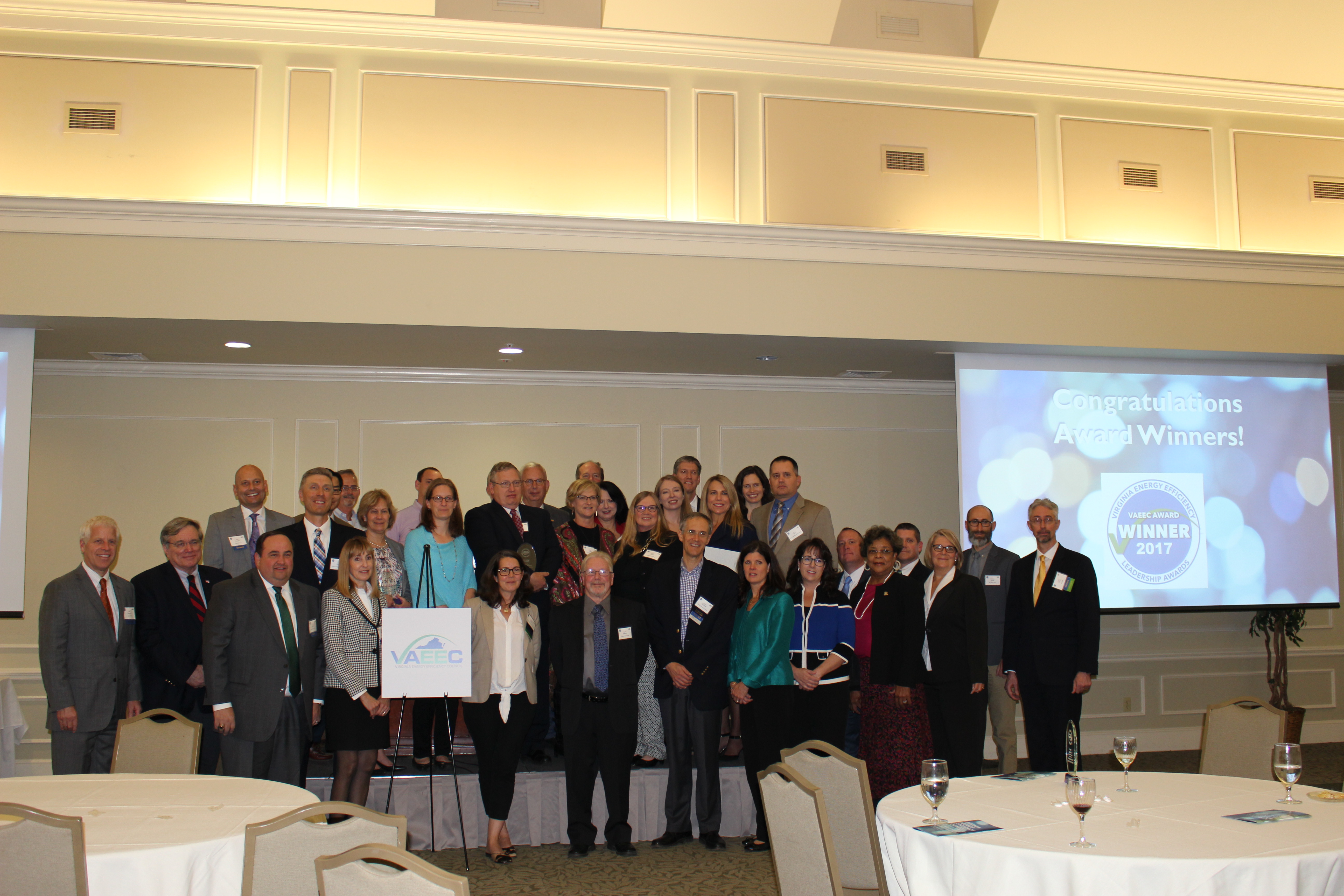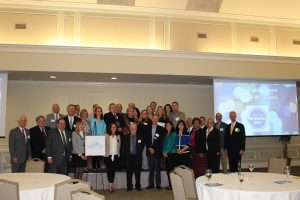2017 Virginia Energy Efficiency Leadership Awards
 2017 Virginia Energy Efficiency Leadership Awards #VaEEleaders
2017 Virginia Energy Efficiency Leadership Awards #VaEEleaders
First Place Winners Include:
- Prince William County Public Schools (Academic)
- Schneider Electric (Commercial)
- Chesterfield County (Local Government)
- Community Housing Partners (Low-Income)
- Northern Virginia Regional Commission/Local Energy Alliance Program (Residential)
- Department of Mines, Minerals and Energy (State Government)
The Virginia Energy Efficiency Council (VAEEC) honored the winners of its 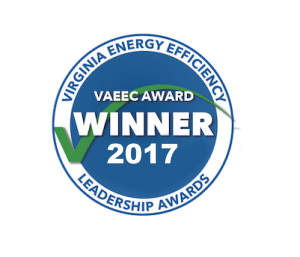 2nd annual Virginia Energy Efficiency Leadership Awards at a reception in Richmond November 2 attended by more than 125 people as part of the VAEEC Fall Meeting. Governor McAuliffe received the first-ever Award of Excellence for his leadership on energy efficiency during his tenure as Governor.
2nd annual Virginia Energy Efficiency Leadership Awards at a reception in Richmond November 2 attended by more than 125 people as part of the VAEEC Fall Meeting. Governor McAuliffe received the first-ever Award of Excellence for his leadership on energy efficiency during his tenure as Governor.
VAEEC received more than 45 nominations for the 6 awards which showcase how energy efficiency champions across the Commonwealth are helping businesses, schools, government and homeowners save money on energy expenditures while reducing energy consumption — all while stimulating job growth and our economy.
“The winning entries are proof that energy efficiency has tremendous  potential to drive economic growth, create jobs, shrink utility bills, conserve natural resources and reduce pollution,” said Chelsea Harnish, VAEEC Executive Director. “The American Council for an Energy Efficient Economy just named Virginia one of three “Most Improved States” in its 2017 State Energy Efficiency Scorecard, and these winners reflect the type of innovative, forward-thinking projects that will keep that momentum going in the Commonwealth.”
potential to drive economic growth, create jobs, shrink utility bills, conserve natural resources and reduce pollution,” said Chelsea Harnish, VAEEC Executive Director. “The American Council for an Energy Efficient Economy just named Virginia one of three “Most Improved States” in its 2017 State Energy Efficiency Scorecard, and these winners reflect the type of innovative, forward-thinking projects that will keep that momentum going in the Commonwealth.”
The ACEEE report together with these Awards follow on the heels of VAEEC’s recent report which highlighted energy efficiency as a $1.5B industry in Virginia, supporting 75K jobs.
The winners represent innovative, results-oriented approaches that are saving homeowners, renters, schools, local and state governments — indeed, every one of us as taxpayers — millions every year: From instituting an Energy Management Office for a school district to retrofitting state buildings that house the Governor’s Office and Supreme Court of Virginia to energy performance contracting for a hospital to a certified LEED Gold convention center to weatherization that could save low-income families hundreds of dollars annually.
Winners: 2017 Virginia Energy Efficiency Leadership Awards (Project Summaries below)
Academic
1st Place: Prince William County Public Schools
Submitted by: Moseley Architects
2nd Place: St. Catherine’s School
Submitted by St. Catherine’s School
3rd Place: Fairfax County Public Schools
Submitted by Fairfax County Public Schools
Commercial
1st Place: Schneider Electric
Submitted by DMME
2nd Place: Sentara Williamsburg Regional Medical Center + Damuth Trane
Submitted by Damuth Trane
3rd Place: Brighter Communities
Submitted by Brighter Communities
Local Government
1st Place: Chesterfield County
Submitted by Chesterfield County
2nd Place: Virginia Beach Convention Center
Submitted by the Virginia Beach Convention Center
3rd Place: Fauquier County Government + Brighter Communities
Submitted by Brighter Communities
Low-Income
1st Place: Community Housing Partners
Submitted by Community Housing Partners
2nd Place: Windy Hill Foundation + Brighter Communities
Submitted by Brighter Communities
3rd Place: Richmond Region Energy Alliance
Submitted by Richmond Region Energy Alliance
Residential
1st Place: Northern Virginia Regional Commission + Local Energy Alliance Program
Submitted by Northern Virginia Regional Commission
2nd Place: City of Roanoke + Better Building Works, LLC
Submitted by the City of Roanoke
3rd Place: RIC Design Build
Submitted by RIC Design Build
State Government
1st Place: Department of Mines, Minerals and Energy
Submitted by DMME
2nd Place: Blue Ridge Regional Jail Authority
Submitted by Blue Ridge Regional Jail Authority
3rd Place: Virginia Department of Corrections
Submitted by the Virginia Department of Corrections
Any person, entity or group who works on energy efficiency in Virginia was eligible for the Awards which were chosen by a Selection Committee, comprised of members of the VAEEC Education and Outreach Committee and additional volunteer members of VAEEC.
The awards were presented by members of the Selection Committee along with VAEEC Board Vice Chair, David Koogler and Harnish. Those in attendance were also treated to the screening of a new series of short videos highlighting VAEEC’s four focus areas: Building Codes, Energy Performance Contracting, Property Assessed Clean Energy (PACE) Financing, and Utility Energy Efficiency Programs.
Earlier in the day, attendees at VAEEC’s Fall Meeting were treated to sessions on a range of topics from smart home technologies to benchmarking to utility programs. Panelists on the closing panel, Hayes Framme, Deputy Secretary of the Commerce and Trade, and Bob Matthias, Assistant to the City Manager in Virginia Beach, addressed the question, “What’s next for EE in Virginia?” as the Commonwealth prepares for a new Governor and new members of the House of Delegates.
Winner Project Summaries
Academic
1st Place: Prince William County Public Schools
 Created in 2013, the Energy Management Office (EMO) plans and manages School Division energy use and sustainability, improves environmental and fiscal stewardship in facility use, and educates staff and students in energy and environmentally conscious design. Foundations of Energy Conservation was the inaugural project, focused on: maintaining the comfort and safety of teachers, students, and employees; saving utility dollars to reinvest in school board priorities and energy infrastructure improvements; and fostering a culture of sustainability and conservation. The education of faculty and staff in all the county’s K12 schools was the key to the Foundation phase’s success.
Created in 2013, the Energy Management Office (EMO) plans and manages School Division energy use and sustainability, improves environmental and fiscal stewardship in facility use, and educates staff and students in energy and environmentally conscious design. Foundations of Energy Conservation was the inaugural project, focused on: maintaining the comfort and safety of teachers, students, and employees; saving utility dollars to reinvest in school board priorities and energy infrastructure improvements; and fostering a culture of sustainability and conservation. The education of faculty and staff in all the county’s K12 schools was the key to the Foundation phase’s success.
Under the guidance of the Administrative Coordinator, three Energy Education Coordinators worked closely with the teachers and staff at all the county’s schools to help them understand their school’s energy performance, why it was performing that way, and what actions they could personally take to make their school a better performer. Because the EMO tracked energy performance and associated reductions in energy bills at each school, cash rebates were made available to schools with significant performance improvements. Over the first five years of the program, Prince William County Schools distributed $1,800 of rebates back to 95 schools, cut their utility consumption by 20%, and saved $24.4M and 191M kWh of electricity. Perhaps more impressive, the EMO has witnessed the indirect benefit of teachers working what they learned into the academic lessons they teach in the classroom. The Foundations program has matured and the EMO is ready to move into the next phase of energy management, which will focus on student education and behavior modification related to energy conservation.
Education Coordinators worked closely with the teachers and staff at all the county’s schools to help them understand their school’s energy performance, why it was performing that way, and what actions they could personally take to make their school a better performer. Because the EMO tracked energy performance and associated reductions in energy bills at each school, cash rebates were made available to schools with significant performance improvements. Over the first five years of the program, Prince William County Schools distributed $1,800 of rebates back to 95 schools, cut their utility consumption by 20%, and saved $24.4M and 191M kWh of electricity. Perhaps more impressive, the EMO has witnessed the indirect benefit of teachers working what they learned into the academic lessons they teach in the classroom. The Foundations program has matured and the EMO is ready to move into the next phase of energy management, which will focus on student education and behavior modification related to energy conservation.
2nd Place: St. Catherine’s School
St. Catherine’s embarked on a Comprehensive Energy Conservation Plan (CECP) six years ago to determine the most effective approach to affect quantum leap and sustainable energy conservation measures. The result has been the execution of a central heating plant decentralization strategy from inefficient legacy boilers (45% efficiency) to distributed highly efficient energy internet controllable and monitored gas fired boilers rated at 98% efficiency, LED lights throughout campus, the installation of 110 touchless water saving automatic faucets, the implementation of three solar arrays (600 panels – 150 kWh), a Compressed Natural Gas (CNG) fueling station and the purchase of CNG vehicles. Additionally, the school is currently implementing an internet based system to provide a dashboard for energy monitoring of individual buildings. Since implementation, St. Catherine’s School has seen $122,472 in energy savings.
3rd Place: Fairfax County Public Schools
In 2014, Fairfax County Public Schools (FCPS) partnered with Cenergistic to provide energy management, conservation, and educational services division wide. FCPS then assigned a team of energy specialists, engineers and other experts to analyze each aspect of the operations and infrastructure. FCPS’ goal is to ensure that every piece of equipment, and every system, is optimized for effectiveness and efficiency. All energy savings are tracked through a process of Measurement & Verification using a third-party accounting software, EnergyCAP®, which processes additional factors affecting energy use, such as changes in weather patterns, buildings renovations and new construction, student enrollment capacity changes, equipment or use changes and differences in billing cycles. Since the inception of the energy conservation program, FCPS has seen more than $16M in cost avoidance savings and more than a 20% quantifiable reduction in utility use division-wide. The savings generated through the program allow FCPS to set an example for students and the community by investing one-third of every project dollar into increasing energy efficiency and sustainability efforts.
Commercial
1st Place: Schneider Electric
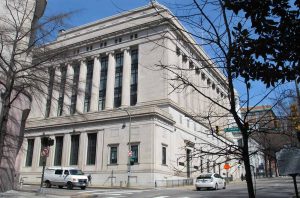 Schneider Electric is implementing a variety of energy conservation measures, including the installation of more than 17,000 high efficiency LED lighting fixtures and more than 500 low-flow plumbing fixtures. The project will impact office, laboratory and warehouse buildings in Richmond, as well as key Department of General Services buildings including the historic Patrick Henry Building, which currently serves as the Governor’s office, and the Supreme Court of Virginia. The older, historic buildings will be retrofitted so they can benefit from modern efficiency measures, while still maintaining their architectural appeal and historic integrity. The project includes six buildings and will result in annual energy and operational savings of $245,000, or $4.1M over the life of the project.
Schneider Electric is implementing a variety of energy conservation measures, including the installation of more than 17,000 high efficiency LED lighting fixtures and more than 500 low-flow plumbing fixtures. The project will impact office, laboratory and warehouse buildings in Richmond, as well as key Department of General Services buildings including the historic Patrick Henry Building, which currently serves as the Governor’s office, and the Supreme Court of Virginia. The older, historic buildings will be retrofitted so they can benefit from modern efficiency measures, while still maintaining their architectural appeal and historic integrity. The project includes six buildings and will result in annual energy and operational savings of $245,000, or $4.1M over the life of the project.
2nd Place: Damuth Trane
Sentara Williamsburg Regional Medical Center (SWRMC), a Certified Primary Stroke Center, has 145 licensed beds and features the latest healthcare technologies. In 2014, the hospital partnered with Damuth Trane, a Professional Energy Services company headquartered in Chesapeake, VA, to perform a building energy tune-up that optimized operation of existing facility systems. Advanced building data collection methods, energy analytics, utility bill analysis and a detailed engineering review uncovered substantial efficiency improvement opportunities. Damuth Trane collaborated with SWRMC staff to implement energy conservation measures to building HVAC and control systems.
The project was justified and funded through utility cost avoidance in the operational budget. In 2016, SWRMC documented a 24% reduction in annual building energy consumption, equating to $647,267 in total avoided utility costs, making the project cash-flow positive within the first year. Continuous data collection, automated analytics, web based reporting tools and remote monitoring were instituted to sustain the efficiency gains. This program is repeatable at similar healthcare facilities.
3rd Place: Brighter Communities
Brighter Communities improved existing functions designed to encourage renewable energy technologies, projects and initiatives through implementing a five-phase plan. Phase One saved significant energy in Fauquier County Government and Fauquier County Public Schools. Phase Two used five websites to document aspects of energy conservation and to display key results, recognize participants / volunteers, and educate viewers with innovative “storyboards”. Additionally, the websites capture energy money savings, carbon footprints, kWh usage, and best practice tips for energy conservation programs, processes and metrics. Phase Three publicly recognized 45 local entities at three events for their energy conservation efforts and a new initiative called the Energy Research – Learning Institute. Phase Four increased local business visibility through a new website that increased community support for their products and services. Phase Five will create new energy conservation software linked to a new website, which will combine the other four repositories into one, easy to navigate site (to be released winter 2017). Buildings are already beginning to see energy savings. For example, the Chestnut Forks Tennis and Fitness Club saved over $3,000 in a 90-day period due to energy conservation efforts, timely usage measurements, and a team approach.
Major players in all of these projects and initiatives include Airlie Foundation, Barrel Oak Winery, Brookside Developments, Chestnut Forks Tennis and Fitness Club, Fauquier Livestock Exchange, Pearmund Cellars, Old Bust Head Brewery, Poplar Springs, Red Truck Bakery, SiteWhirks Software Development, and Vint Hill Craft Winery.
Local Government
1st Place: Chesterfield County
 To be good stewards of the public trust and responsible protectors of the environment, Chesterfield County supports a comprehensive energy management program. The main goal of the program is to reduce energy use while maintaining occupant comfort and productive working environments. In addition to an Energy Management Administrator, instrumental to the program’s success has been procurement of energy management software to monitor cost and use and measure program results.
To be good stewards of the public trust and responsible protectors of the environment, Chesterfield County supports a comprehensive energy management program. The main goal of the program is to reduce energy use while maintaining occupant comfort and productive working environments. In addition to an Energy Management Administrator, instrumental to the program’s success has been procurement of energy management software to monitor cost and use and measure program results.
Initiatives include building use reduction management, large scale lighting retrofits, energy audits of all facilities, rate analysis, energy star submissions, demand response, water use reduction, commissioning, and outreach. Pilot projects include a spray foam insulated unvented roof deck, Nature Neutral Alpen energy-efficient windows, and bi-polar ionization. Education and outreach includes placement of interactive, real-time utility monitoring touch screen kiosks in their 13 middle schools, which allows students to view school energy use in real-time. Chesterfield has also purchased energy auditing and monitoring equipment, and educational materials that can be checked out by teachers and is investigating availability to residents through the library system.
Chesterfield’s energy and building guidelines include LEED certified goals, temperature set points, and energy-efficient behavior expectations and recommendations for employees. A recent LEED certified facility boasts light tubes, large rainwater collection underground cistern, pervious pavement, and an energy model of 24.8% less energy.
Savings and impacts of the program are far reaching, varied, and significant. Over the past five years, the County has seen a cumulative annual savings of more than $1.3M.
2nd Place: Virginia Beach Convention Center
Certified by the U.S. Green Building Council in 2010 and 2015, the LEED® Gold Virginia Beach Convention Center (VBCC) has been committed to energy-efficient operations since opening in 2007. As one of Virginia Beach’s largest buildings, VBCC uses an average of 604,000 kilowatt hours of electricity per month. Most recently, VBCC upgraded the lighting in the exhibit hall from metal halide to energy-efficient LEDs and implemented an automated electricity demand response program as part of VBCC’s heating, cooling, air conditioning and ventilation (HVAC) building controls. The demand response program is designed to limit the building’s peak power supply demand, which in turn lowers the demand placed on the regional power grid.
The program helps VBCC conserve electricity and save money by expanding the temperature set points within the various spaces in the building. Electrical switchgear integration into the building control software provided instantaneous kilowatt usage data. The HVAC controls monitor peak kilowatt usage in real time. At predetermined thresholds, the system automatically adjusts room temperatures by one to three degrees, effectively placing less demand on VBCC’s equipment and using less electricity. Upgrading the lighting and the automated demand response program has reduced the power supply peak demand by 15%, from 2,196 kilowatts to 1863 kilowatts, and saved $20,870 in electricity costs.
3rd Place: Fauquier County Government + Brighter Communities
Fauquier County Government (FCG) devised a 100-hour “volunteer” project to review building utility expenses. This led to the approval of 500 hours of a more in-depth benchmarking program for FCG buildings. Pressure to reduce energy expenses with minimal funding forced innovation and original thinking to revise processes and metrics.
Once building data was benchmarked, FCG began implementing measures to reduce energy use. These included: control changes for non-work hours; timely control system changes to avoid electric utility peak demand charges; and temperature control modifications on holidays. In three years, FCG saved $220,617 in building energy costs. In addition to original average annual costs of about $800K, this represented a savings of approximately 9%.
Low-Income
1st Place: Community Housing Partners
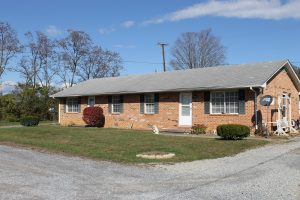 Sun Valley and The Landings are income-qualifying properties located on the outskirts of Radford, VA. Community Housing Partners (CHP) recently acquired the nearly identical properties consisting of 21 duplexes totaling 42 residences. All units use electric-resistance baseboard heating as their primary heat source and window A/C units for cooling.
Sun Valley and The Landings are income-qualifying properties located on the outskirts of Radford, VA. Community Housing Partners (CHP) recently acquired the nearly identical properties consisting of 21 duplexes totaling 42 residences. All units use electric-resistance baseboard heating as their primary heat source and window A/C units for cooling.
In mid-2017, at the request of Virginia’s Department of Housing and Community Development (DHCD) to explore opportunities for applying federally-funded Weatherization Assistance Program toward more multi-family properties in Virginia, CHP pooled together resources to conduct a deep-energy retrofit on the properties. Coinciding with Weatherization Assistance Program funds, additional funds were leveraged from the Low Income Home Energy Assistance Program (LIHEAP), Appalachian Power Company’s (APCo) Low-Income Weatherization Program, CHP Energy Solutions Emergency Home and Accessibility Repair Program, as well as an owner-contribution from CHP.
The scope of work developed would impact nearly all building systems and components: LED lighting, low-flow fixtures, water heater tank and hot water pipe insulation, making the building envelope more airtight, installing floor and attic insulation, and replacing the baseboard heating with a 16 SEER heat pump and air-sealed duct work. Saving estimates produced by the Department of Energy’s National Energy Audit Tool (NEAT) project an average 73% annual heating load reduction for each unit. Based on these projections, annual utility bills savings could amount to nearly $850 per household.
Behind the scenes, administrators and managers balanced the needs and requirements of all stakeholders involved in the project, including property maintenance and management staff, residents, DHCD, APCo, multiple subcontractors, and several stakeholders within the different departments of CHP. The experience learned from Sun Valley and The Landings will be applied to streamline future projects leveraging multiple funding sources.
2nd Place: Windy Hill Foundation + Brighter Communities
Windy Hill Foundation built 12 all-electric workforce housing units in The Plains, Virginia, which were certified EarthCraft. The housing units included two- and three-bedroom floor plans with identical layouts. Key building attributes included geothermal heating / cooling, high R-value insulation, metal roofs, geothermal water heaters, energy efficient windows / doors, and natural water retention / marsh areas on the property.
Energy Efficiency training was provided to residents and utility energy data was collected for 18 months. Energy usage was reduced in most units by 8% with some as high as 22%, indicating that occupant awareness, habits, and knowledge combined with timely results are essential to reducing energy usage.
3rd Place: Richmond Region Energy Alliance
The EnergizeRVA program improves the home energy performance for low-moderate income homeowners and renters, whose family budgets are most burdened by high energy costs, but who do not qualify for other programs. EnergizeRVA trains volunteers and program recipients to install energy savings measures and provides them with information they can use for future improvements. Forty homes participated in the pilot program’s first year, and the program was able to reach it’s goal of achieving an average of 10% energy savings for the entire portfolio. All of the installed efficiency measures have a return on investment of six months to three years and clients can expect to save on average $150 per year on their utility bills.
The lessons learned from this pilot program will be carried forward in future efforts to educate homeowners and help them improve their home’s energy efficiency and comfort, while saving money on utilities.
Residential
1st Place: Northern Virginia Regional Commission + Local Energy Alliance Program
Solarize NoVA is a campaign coordinated with the Local Energy Alliance 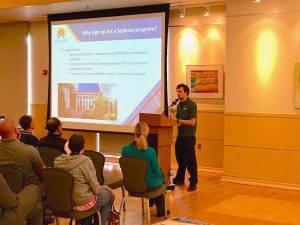 Program that links home energy efficiency with solar photovoltaic. Since its inception in 2014, more than 4,000 residents and businesses in Northern Virginia have signed up for the program. To date, the program has resulted in: 630 home energy checkups, resulting in 453,600 kWh saved; 15 completed multi-family apartment weatherization projects, resulting in 262,955 kWh saved; as well as 176 contracts for more than 1.3 MW of new solar installed with a contract value of more than $4.2M. All totaled, the efficiency measures and solar installations replace 2.5M kWh of electricity that does not have to be generated by a power plant. The dollar value of the energy saved or produced is $277,003 on an annual basis.
Program that links home energy efficiency with solar photovoltaic. Since its inception in 2014, more than 4,000 residents and businesses in Northern Virginia have signed up for the program. To date, the program has resulted in: 630 home energy checkups, resulting in 453,600 kWh saved; 15 completed multi-family apartment weatherization projects, resulting in 262,955 kWh saved; as well as 176 contracts for more than 1.3 MW of new solar installed with a contract value of more than $4.2M. All totaled, the efficiency measures and solar installations replace 2.5M kWh of electricity that does not have to be generated by a power plant. The dollar value of the energy saved or produced is $277,003 on an annual basis.
The program has brought together the various local government jurisdictions through the Northern Virginia region to share this important program with residents and serves as a model in the Commonwealth on how government, the not-for-profit sector and the private sector can work together to achieve these results.
2nd Place: City of Roanoke + Better Building Works, LLC
Weatherize Roanoke is a “One Stop Shop” for free, affordable energy efficiency services for homes in the City of Roanoke. Ultimately, the service area was expanded to include the greater Roanoke Valley. The city convened public and private partners as stakeholders to aggregate available services into one program. Providing affordable energy efficiency to middle-income consumers is a longstanding ‘wicked problem’ since most existing building stock is decades old. Creating a public-private strategy bridges these gaps, and Weatherize Roanoke used energy efficiency as a catalyst.
Partnering with Better Building Works helped transform the traditional weatherization program. Their ‘building-as-a-system’ process made energy efficiency a catalyst for water use reduction, indoor air quality and public education. Neighborhood meetings showcased the Weatherize Roanoke website and registration for a free Energy Review. Homeowners received LED light bulbs, water heater blankets, water pipe insulation, low-flow showerheads and customized recommendations for home performance. On average, homeowners saved $78, 583 electric kWh, and 381 natural gas Therms a year. The City saw a 128% return on investment (in dollars to the local economy) at year one.
This project demonstrates how communities can broaden utility-sponsored programs through diversifying stakeholders beyond the traditional low-income focus.
3rd Place: RIC Design Build
This 1924 Museum District rowhouse underwent a top-to-bottom renovation, enhancing and preserving its historic features while improving both functionality and energy efficiency for a new century of family life. Improvements included the conversion of a dark, damp basement and an unconditioned sun porch into fully-finished and conditioned spaces, adding 800 square feet of living space within the home’s original footprint. Elsewhere, interior partition walls were removed, an original skylight was restored and insulated glass doors were added on each floor to bring natural light into the home and decrease the need for daytime artificial lighting. Energy Star appliances and new light fixtures were installed throughout and a new HVAC system was added for a whole-house upgrade in energy efficiency. After completion of the renovation, the Energy Score was improved from 40,000 kWh per year to 17,000 kWh. This project illustrates the value of pairing aesthetic improvements with energy-saving upgrades, and integrating comfort and sustainability into a thoughtful renovation.
State Government
1st Place: Department of Mines, Minerals and Energy
![]() The VirginiaSAVES Green Communities Program was enabled by Governor McAuliffe in 2015 by Executive Order 36. The program was developed to utilize Virginia’s full allocation of Qualified Energy Conservation Bonds (QECBs) issued by the US Treasury. It has done so, by providing subsidized low-cost financing to school districts, commercial, industrial, non-profit, institutional and local government borrowers without adding debt to the Commonwealth. The Virginia Department of Mines, Minerals, and Energy (DMME) developed the program in partnership with program administrator CleanSource Capital, and conduit bond issuers Virginia Small Business Financing Authority and Virginia Resources Authority. Virginia Community Capital leads outreach and marketing efforts to connect project developers and clients with the program opportunity. Private sector lenders and energy services contractors are also vital partners.
The VirginiaSAVES Green Communities Program was enabled by Governor McAuliffe in 2015 by Executive Order 36. The program was developed to utilize Virginia’s full allocation of Qualified Energy Conservation Bonds (QECBs) issued by the US Treasury. It has done so, by providing subsidized low-cost financing to school districts, commercial, industrial, non-profit, institutional and local government borrowers without adding debt to the Commonwealth. The Virginia Department of Mines, Minerals, and Energy (DMME) developed the program in partnership with program administrator CleanSource Capital, and conduit bond issuers Virginia Small Business Financing Authority and Virginia Resources Authority. Virginia Community Capital leads outreach and marketing efforts to connect project developers and clients with the program opportunity. Private sector lenders and energy services contractors are also vital partners.
To date, VirginiaSAVES has closed loans for 12 large energy performance contracts, across the Commonwealth. Clients include private businesses, local governments and educational facilities and projects encompass over 130 buildings with nearly six million square feet of conditioned space. Building retrofits financed through the program have guaranteed energy cost savings of $63.9 million over the life of the projects, which will help these organizations enhance their financial stability by reducing operating costs, improving cash flow, and freeing up resources for other investments that will benefit their communities. Annual greenhouse gas emissions from these projects will be reduced by over 16,000 metric tons. The projects will also create 755 jobs, with priority given to utilizing local contractors to perform the work, creating a “ripple effect” in local communities.
The success of VirginiaSAVES also positions Virginia well for potential future allocations of QECBs, and may open up new opportunities for bond financing of energy efficiency projects using other sources.
2nd Place: Blue Ridge Regional Jail Authority
In 2014, the Blue Ridge Regional Jail Authority (BRRJA) entered into a guaranteed energy savings contract with Honeywell. The $3.9M project has a 15-year savings guarantee and was designed to create energy efficiency and taxpayer savings among all five of the BRRJA jail facilities in Central and Southside Virginia, while creating a full project payback timeframe of eleven years and nine months. BRRJA will continue to reap this financial reward well into the future. Years of fiscal responsibility by the Authority’s Board of Directors afforded Blue Ridge the opportunity to pay for the project out of reserve money. Financing the project would have meant lost opportunities to include more Energy Conservation Measures in the project. BRRJA chose to maximize its energy savings potential by avoiding loan interest
Almost half of the overall project cost was devoted to lighting and water retrofit upgrades. Communicating water conservation systems were installed in the Lynchburg and Halifax jails. BRRJA is pleased to include that the Amherst jail is LEED Silver certified! Guaranteed energy and operations savings from Honeywell totaled $334,568 in year one and is projected to increase by 2.5% annually for the 15-year life of said guarantee. Completing the energy savings project aided the BRRJA in fulfilling its overall mission of supporting the criminal justice system by operating its centers in a manner that produces a safe and secure environment for the public, staff, and inmates.
3rd Place: Virginia Department of Corrections
The Department of Corrections’ (DOC) Greensville Correctional Center is Virginia’s largest prison, housing approximately 3,000 inmates. Efficiency improvements at the boiler plant will save $231,410 the first year. The project will also install LED lighting to replace existing yard lights, leading to $48,261 in savings the first year. DOC plans to re-invest that savings in electrical system replacements that are crucial to prison’s operation, but which could not be funded by capital.

